Clinical Integration Specialty Practice: Safety and Legal Report
VerifiedAdded on 2022/12/29
|6
|1524
|62
Report
AI Summary
This report provides a detailed analysis of a medication error incident that occurred in an Australian Intensive Care Unit (ICU). The report identifies the physical and emotional safety issues faced by the patient due to the nurse's error of administering the wrong medication (epinephrine). It explores strategies to mitigate such issues, emphasizing adherence to the five rights of medication administration, medication reconciliation, and proper documentation. The role of the specialist nurse, as per NMBA standards, is discussed, highlighting the importance of evidence-based practice, patient-centered care, and professional conduct. The legal aspects associated with the specialty are also examined, including the Nurse Practice Act and the nurse's responsibility as a patient advocate. The report concludes by emphasizing the need for nurses to implement safety protocols and enhance their professional skills to prevent future medication errors and ensure patient safety. This report highlights the importance of following nursing standards and legal guidelines to provide safe and quality care to patients in a specialty clinical setting.
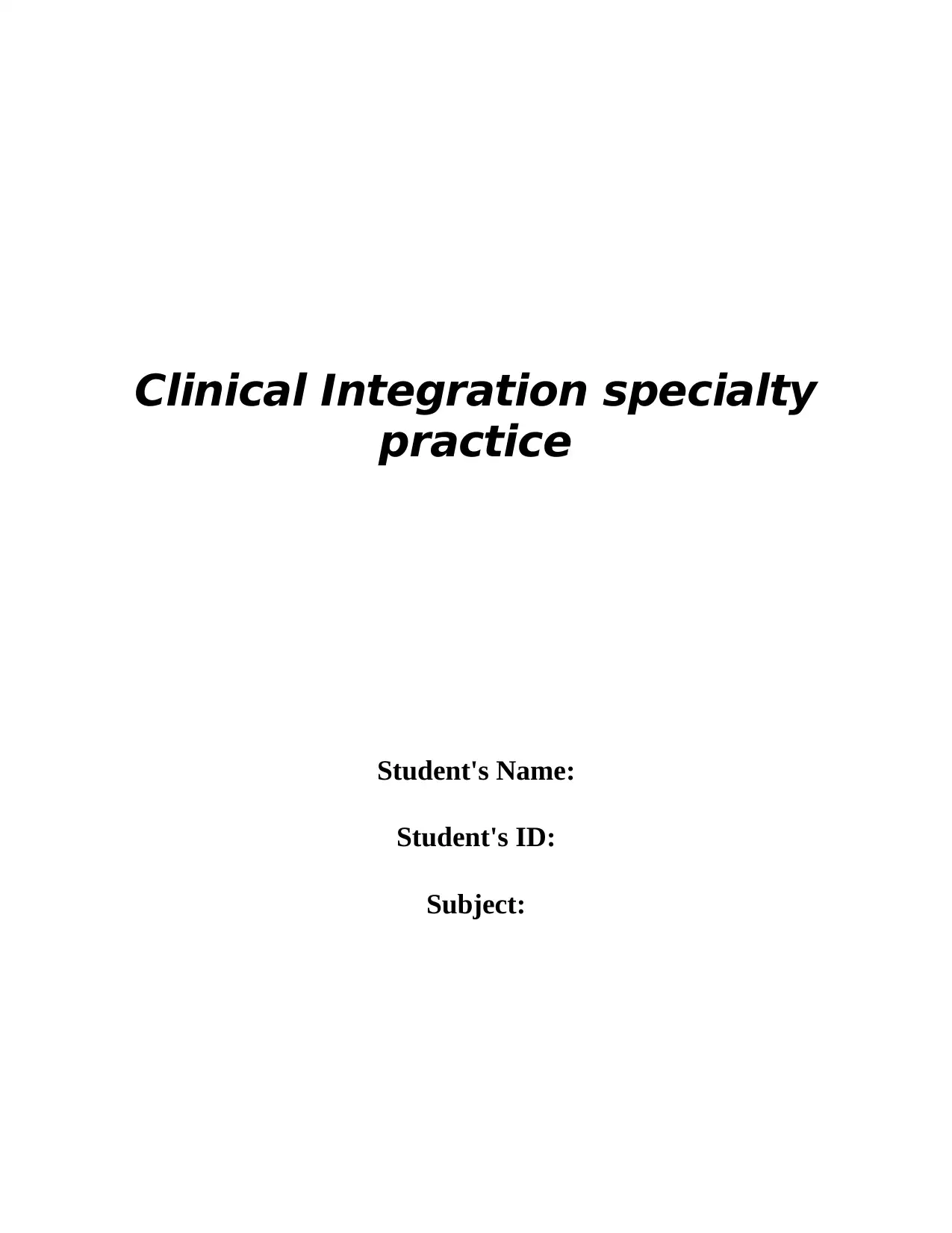
Clinical Integration specialty
practice
Student's Name:
Student's ID:
Subject:
practice
Student's Name:
Student's ID:
Subject:
Paraphrase This Document
Need a fresh take? Get an instant paraphrase of this document with our AI Paraphraser
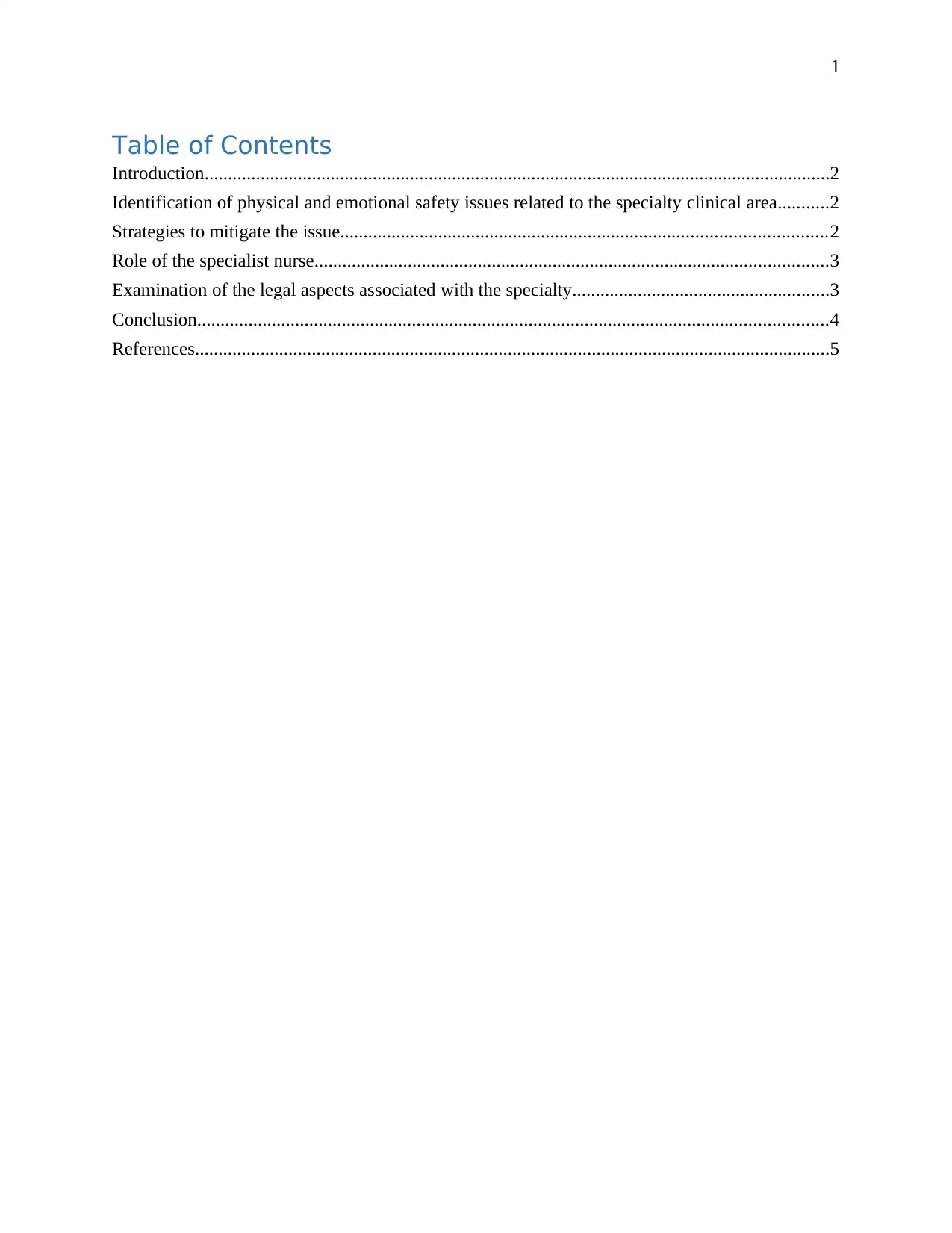
1
Table of Contents
Introduction......................................................................................................................................2
Identification of physical and emotional safety issues related to the specialty clinical area...........2
Strategies to mitigate the issue........................................................................................................2
Role of the specialist nurse..............................................................................................................3
Examination of the legal aspects associated with the specialty.......................................................3
Conclusion.......................................................................................................................................4
References........................................................................................................................................5
Table of Contents
Introduction......................................................................................................................................2
Identification of physical and emotional safety issues related to the specialty clinical area...........2
Strategies to mitigate the issue........................................................................................................2
Role of the specialist nurse..............................................................................................................3
Examination of the legal aspects associated with the specialty.......................................................3
Conclusion.......................................................................................................................................4
References........................................................................................................................................5
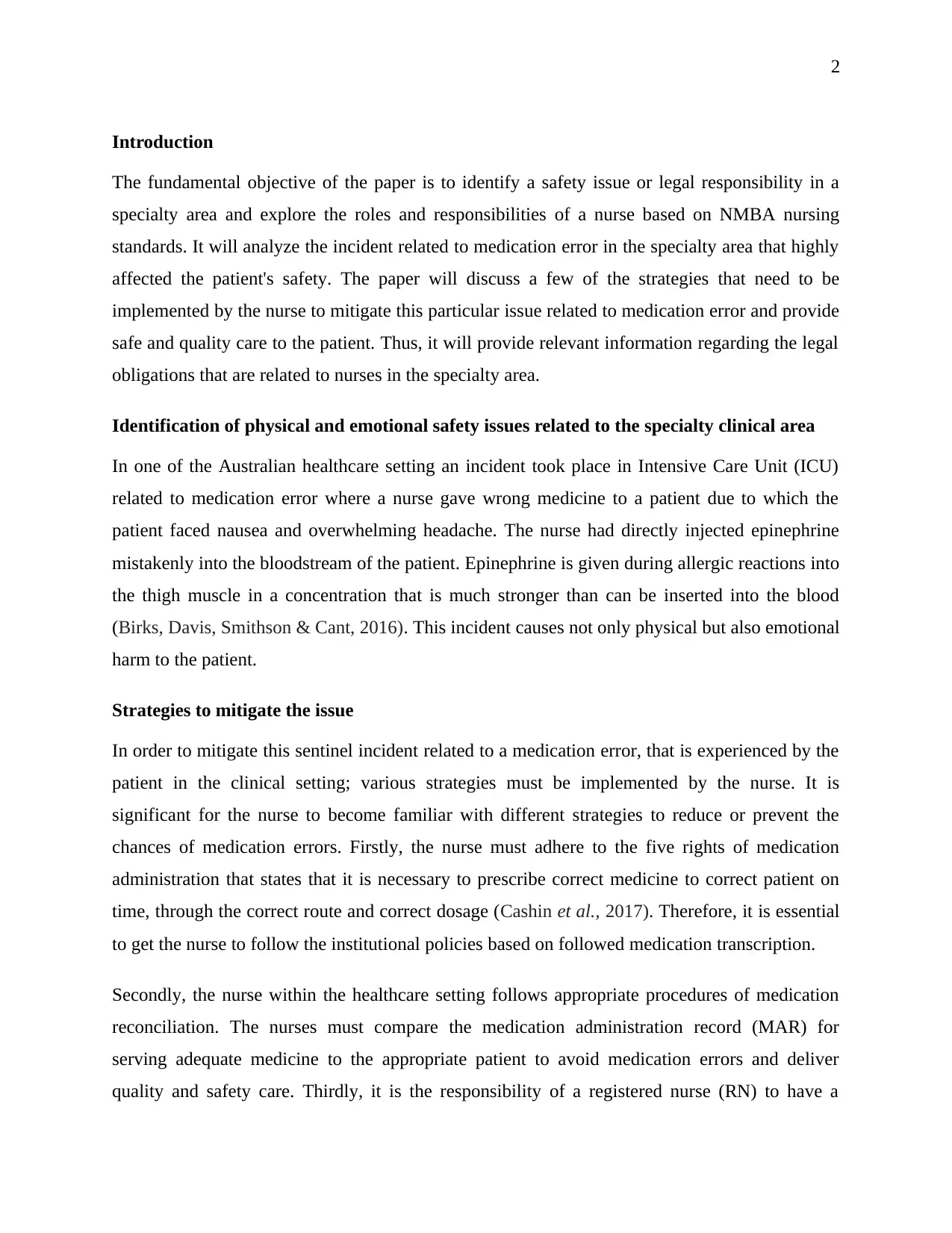
2
Introduction
The fundamental objective of the paper is to identify a safety issue or legal responsibility in a
specialty area and explore the roles and responsibilities of a nurse based on NMBA nursing
standards. It will analyze the incident related to medication error in the specialty area that highly
affected the patient's safety. The paper will discuss a few of the strategies that need to be
implemented by the nurse to mitigate this particular issue related to medication error and provide
safe and quality care to the patient. Thus, it will provide relevant information regarding the legal
obligations that are related to nurses in the specialty area.
Identification of physical and emotional safety issues related to the specialty clinical area
In one of the Australian healthcare setting an incident took place in Intensive Care Unit (ICU)
related to medication error where a nurse gave wrong medicine to a patient due to which the
patient faced nausea and overwhelming headache. The nurse had directly injected epinephrine
mistakenly into the bloodstream of the patient. Epinephrine is given during allergic reactions into
the thigh muscle in a concentration that is much stronger than can be inserted into the blood
(Birks, Davis, Smithson & Cant, 2016). This incident causes not only physical but also emotional
harm to the patient.
Strategies to mitigate the issue
In order to mitigate this sentinel incident related to a medication error, that is experienced by the
patient in the clinical setting; various strategies must be implemented by the nurse. It is
significant for the nurse to become familiar with different strategies to reduce or prevent the
chances of medication errors. Firstly, the nurse must adhere to the five rights of medication
administration that states that it is necessary to prescribe correct medicine to correct patient on
time, through the correct route and correct dosage (Cashin et al., 2017). Therefore, it is essential
to get the nurse to follow the institutional policies based on followed medication transcription.
Secondly, the nurse within the healthcare setting follows appropriate procedures of medication
reconciliation. The nurses must compare the medication administration record (MAR) for
serving adequate medicine to the appropriate patient to avoid medication errors and deliver
quality and safety care. Thirdly, it is the responsibility of a registered nurse (RN) to have a
Introduction
The fundamental objective of the paper is to identify a safety issue or legal responsibility in a
specialty area and explore the roles and responsibilities of a nurse based on NMBA nursing
standards. It will analyze the incident related to medication error in the specialty area that highly
affected the patient's safety. The paper will discuss a few of the strategies that need to be
implemented by the nurse to mitigate this particular issue related to medication error and provide
safe and quality care to the patient. Thus, it will provide relevant information regarding the legal
obligations that are related to nurses in the specialty area.
Identification of physical and emotional safety issues related to the specialty clinical area
In one of the Australian healthcare setting an incident took place in Intensive Care Unit (ICU)
related to medication error where a nurse gave wrong medicine to a patient due to which the
patient faced nausea and overwhelming headache. The nurse had directly injected epinephrine
mistakenly into the bloodstream of the patient. Epinephrine is given during allergic reactions into
the thigh muscle in a concentration that is much stronger than can be inserted into the blood
(Birks, Davis, Smithson & Cant, 2016). This incident causes not only physical but also emotional
harm to the patient.
Strategies to mitigate the issue
In order to mitigate this sentinel incident related to a medication error, that is experienced by the
patient in the clinical setting; various strategies must be implemented by the nurse. It is
significant for the nurse to become familiar with different strategies to reduce or prevent the
chances of medication errors. Firstly, the nurse must adhere to the five rights of medication
administration that states that it is necessary to prescribe correct medicine to correct patient on
time, through the correct route and correct dosage (Cashin et al., 2017). Therefore, it is essential
to get the nurse to follow the institutional policies based on followed medication transcription.
Secondly, the nurse within the healthcare setting follows appropriate procedures of medication
reconciliation. The nurses must compare the medication administration record (MAR) for
serving adequate medicine to the appropriate patient to avoid medication errors and deliver
quality and safety care. Thirdly, it is the responsibility of a registered nurse (RN) to have a
⊘ This is a preview!⊘
Do you want full access?
Subscribe today to unlock all pages.

Trusted by 1+ million students worldwide
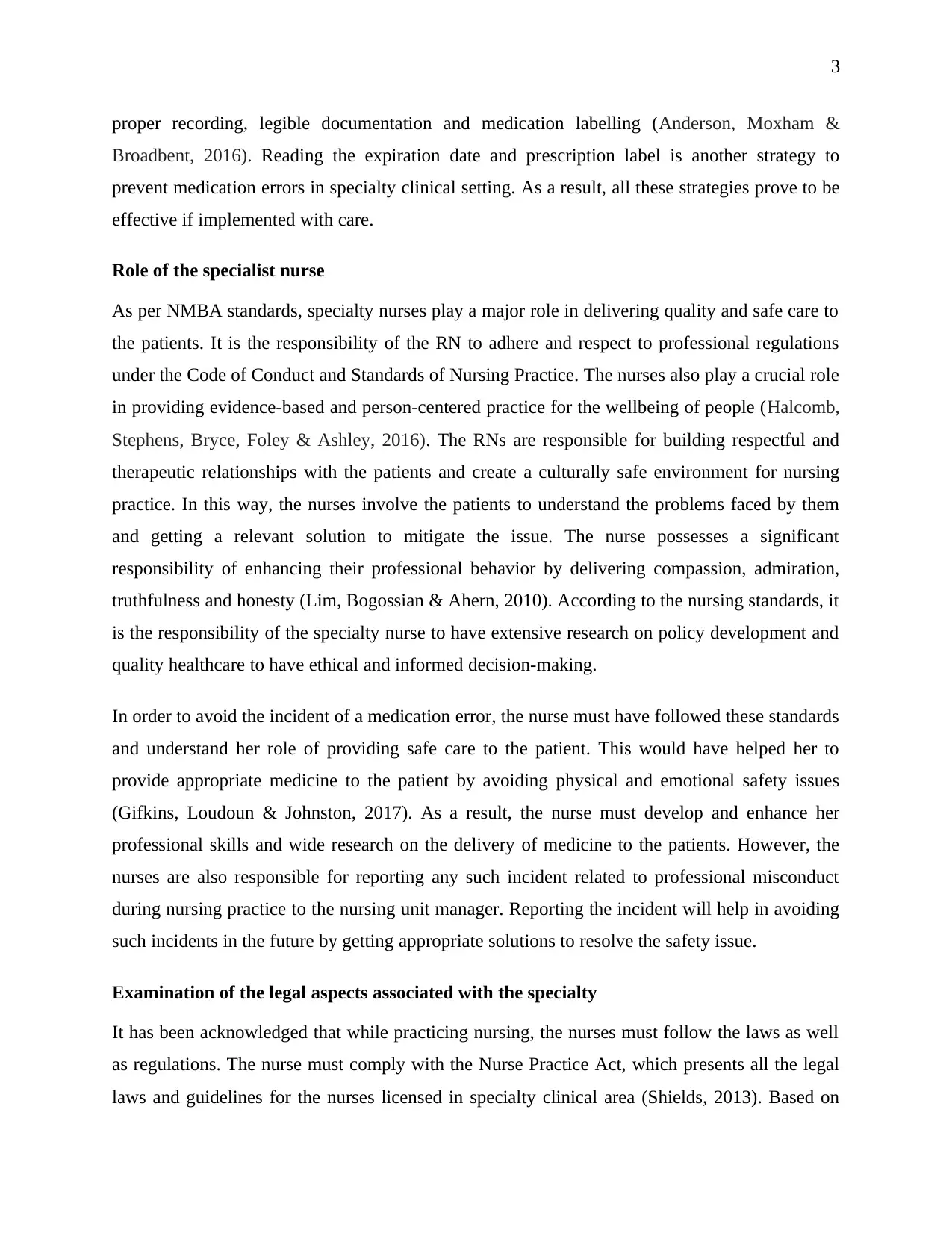
3
proper recording, legible documentation and medication labelling (Anderson, Moxham &
Broadbent, 2016). Reading the expiration date and prescription label is another strategy to
prevent medication errors in specialty clinical setting. As a result, all these strategies prove to be
effective if implemented with care.
Role of the specialist nurse
As per NMBA standards, specialty nurses play a major role in delivering quality and safe care to
the patients. It is the responsibility of the RN to adhere and respect to professional regulations
under the Code of Conduct and Standards of Nursing Practice. The nurses also play a crucial role
in providing evidence-based and person-centered practice for the wellbeing of people (Halcomb,
Stephens, Bryce, Foley & Ashley, 2016). The RNs are responsible for building respectful and
therapeutic relationships with the patients and create a culturally safe environment for nursing
practice. In this way, the nurses involve the patients to understand the problems faced by them
and getting a relevant solution to mitigate the issue. The nurse possesses a significant
responsibility of enhancing their professional behavior by delivering compassion, admiration,
truthfulness and honesty (Lim, Bogossian & Ahern, 2010). According to the nursing standards, it
is the responsibility of the specialty nurse to have extensive research on policy development and
quality healthcare to have ethical and informed decision-making.
In order to avoid the incident of a medication error, the nurse must have followed these standards
and understand her role of providing safe care to the patient. This would have helped her to
provide appropriate medicine to the patient by avoiding physical and emotional safety issues
(Gifkins, Loudoun & Johnston, 2017). As a result, the nurse must develop and enhance her
professional skills and wide research on the delivery of medicine to the patients. However, the
nurses are also responsible for reporting any such incident related to professional misconduct
during nursing practice to the nursing unit manager. Reporting the incident will help in avoiding
such incidents in the future by getting appropriate solutions to resolve the safety issue.
Examination of the legal aspects associated with the specialty
It has been acknowledged that while practicing nursing, the nurses must follow the laws as well
as regulations. The nurse must comply with the Nurse Practice Act, which presents all the legal
laws and guidelines for the nurses licensed in specialty clinical area (Shields, 2013). Based on
proper recording, legible documentation and medication labelling (Anderson, Moxham &
Broadbent, 2016). Reading the expiration date and prescription label is another strategy to
prevent medication errors in specialty clinical setting. As a result, all these strategies prove to be
effective if implemented with care.
Role of the specialist nurse
As per NMBA standards, specialty nurses play a major role in delivering quality and safe care to
the patients. It is the responsibility of the RN to adhere and respect to professional regulations
under the Code of Conduct and Standards of Nursing Practice. The nurses also play a crucial role
in providing evidence-based and person-centered practice for the wellbeing of people (Halcomb,
Stephens, Bryce, Foley & Ashley, 2016). The RNs are responsible for building respectful and
therapeutic relationships with the patients and create a culturally safe environment for nursing
practice. In this way, the nurses involve the patients to understand the problems faced by them
and getting a relevant solution to mitigate the issue. The nurse possesses a significant
responsibility of enhancing their professional behavior by delivering compassion, admiration,
truthfulness and honesty (Lim, Bogossian & Ahern, 2010). According to the nursing standards, it
is the responsibility of the specialty nurse to have extensive research on policy development and
quality healthcare to have ethical and informed decision-making.
In order to avoid the incident of a medication error, the nurse must have followed these standards
and understand her role of providing safe care to the patient. This would have helped her to
provide appropriate medicine to the patient by avoiding physical and emotional safety issues
(Gifkins, Loudoun & Johnston, 2017). As a result, the nurse must develop and enhance her
professional skills and wide research on the delivery of medicine to the patients. However, the
nurses are also responsible for reporting any such incident related to professional misconduct
during nursing practice to the nursing unit manager. Reporting the incident will help in avoiding
such incidents in the future by getting appropriate solutions to resolve the safety issue.
Examination of the legal aspects associated with the specialty
It has been acknowledged that while practicing nursing, the nurses must follow the laws as well
as regulations. The nurse must comply with the Nurse Practice Act, which presents all the legal
laws and guidelines for the nurses licensed in specialty clinical area (Shields, 2013). Based on
Paraphrase This Document
Need a fresh take? Get an instant paraphrase of this document with our AI Paraphraser
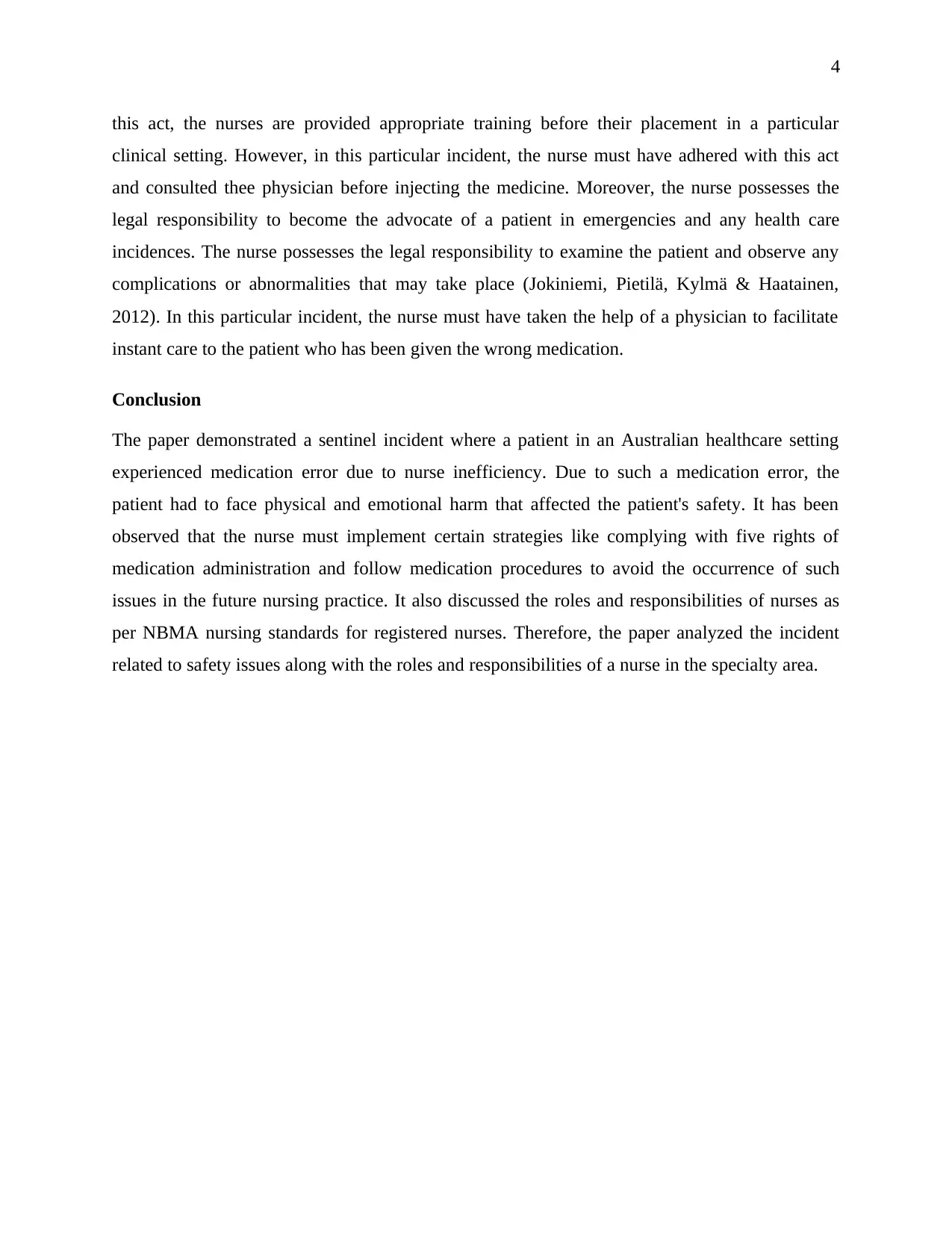
4
this act, the nurses are provided appropriate training before their placement in a particular
clinical setting. However, in this particular incident, the nurse must have adhered with this act
and consulted thee physician before injecting the medicine. Moreover, the nurse possesses the
legal responsibility to become the advocate of a patient in emergencies and any health care
incidences. The nurse possesses the legal responsibility to examine the patient and observe any
complications or abnormalities that may take place (Jokiniemi, Pietilä, Kylmä & Haatainen,
2012). In this particular incident, the nurse must have taken the help of a physician to facilitate
instant care to the patient who has been given the wrong medication.
Conclusion
The paper demonstrated a sentinel incident where a patient in an Australian healthcare setting
experienced medication error due to nurse inefficiency. Due to such a medication error, the
patient had to face physical and emotional harm that affected the patient's safety. It has been
observed that the nurse must implement certain strategies like complying with five rights of
medication administration and follow medication procedures to avoid the occurrence of such
issues in the future nursing practice. It also discussed the roles and responsibilities of nurses as
per NBMA nursing standards for registered nurses. Therefore, the paper analyzed the incident
related to safety issues along with the roles and responsibilities of a nurse in the specialty area.
this act, the nurses are provided appropriate training before their placement in a particular
clinical setting. However, in this particular incident, the nurse must have adhered with this act
and consulted thee physician before injecting the medicine. Moreover, the nurse possesses the
legal responsibility to become the advocate of a patient in emergencies and any health care
incidences. The nurse possesses the legal responsibility to examine the patient and observe any
complications or abnormalities that may take place (Jokiniemi, Pietilä, Kylmä & Haatainen,
2012). In this particular incident, the nurse must have taken the help of a physician to facilitate
instant care to the patient who has been given the wrong medication.
Conclusion
The paper demonstrated a sentinel incident where a patient in an Australian healthcare setting
experienced medication error due to nurse inefficiency. Due to such a medication error, the
patient had to face physical and emotional harm that affected the patient's safety. It has been
observed that the nurse must implement certain strategies like complying with five rights of
medication administration and follow medication procedures to avoid the occurrence of such
issues in the future nursing practice. It also discussed the roles and responsibilities of nurses as
per NBMA nursing standards for registered nurses. Therefore, the paper analyzed the incident
related to safety issues along with the roles and responsibilities of a nurse in the specialty area.
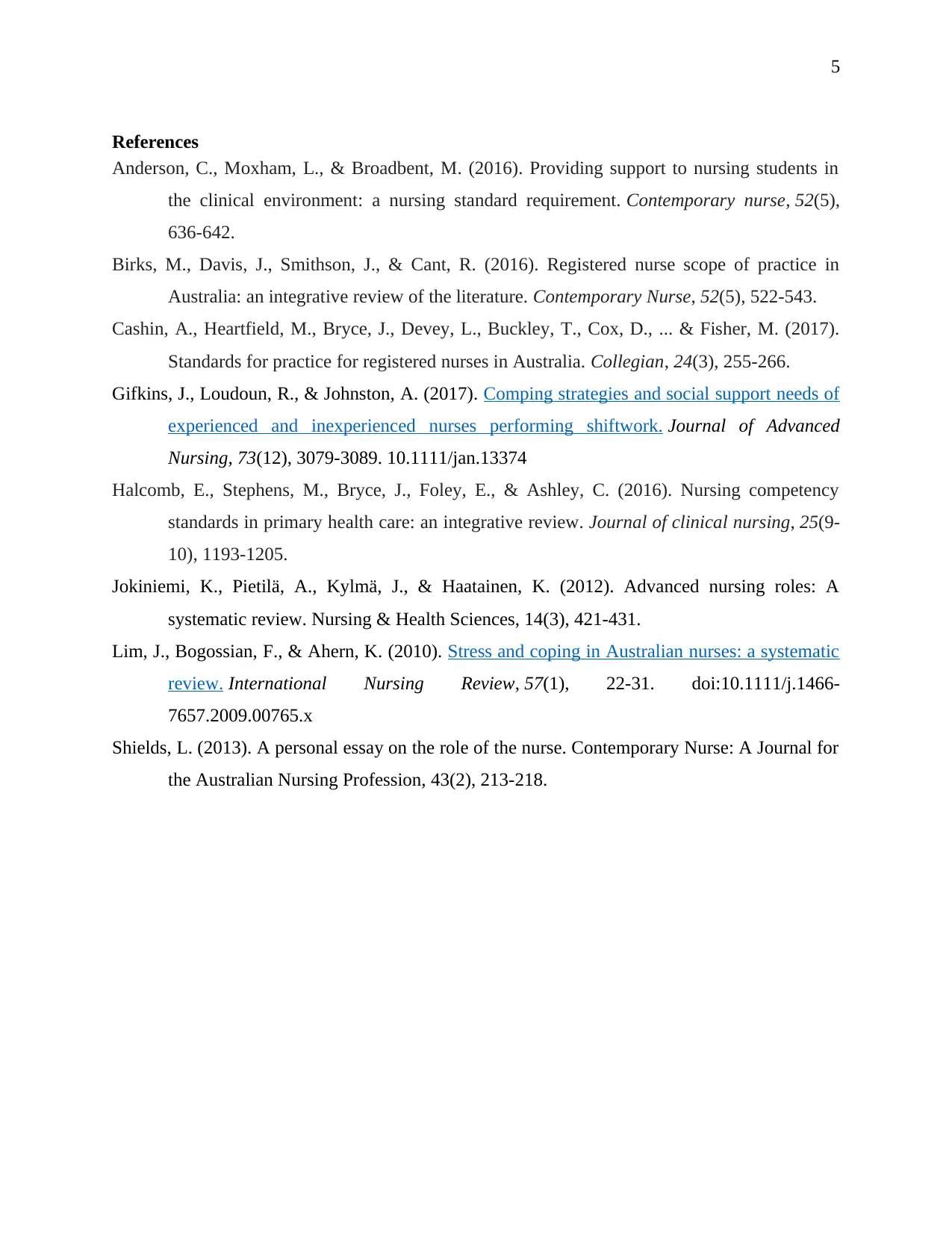
5
References
Anderson, C., Moxham, L., & Broadbent, M. (2016). Providing support to nursing students in
the clinical environment: a nursing standard requirement. Contemporary nurse, 52(5),
636-642.
Birks, M., Davis, J., Smithson, J., & Cant, R. (2016). Registered nurse scope of practice in
Australia: an integrative review of the literature. Contemporary Nurse, 52(5), 522-543.
Cashin, A., Heartfield, M., Bryce, J., Devey, L., Buckley, T., Cox, D., ... & Fisher, M. (2017).
Standards for practice for registered nurses in Australia. Collegian, 24(3), 255-266.
Gifkins, J., Loudoun, R., & Johnston, A. (2017). Comping strategies and social support needs of
experienced and inexperienced nurses performing shiftwork. Journal of Advanced
Nursing, 73(12), 3079-3089. 10.1111/jan.13374
Halcomb, E., Stephens, M., Bryce, J., Foley, E., & Ashley, C. (2016). Nursing competency
standards in primary health care: an integrative review. Journal of clinical nursing, 25(9-
10), 1193-1205.
Jokiniemi, K., Pietilä, A., Kylmä, J., & Haatainen, K. (2012). Advanced nursing roles: A
systematic review. Nursing & Health Sciences, 14(3), 421-431.
Lim, J., Bogossian, F., & Ahern, K. (2010). Stress and coping in Australian nurses: a systematic
review. International Nursing Review, 57(1), 22-31. doi:10.1111/j.1466-
7657.2009.00765.x
Shields, L. (2013). A personal essay on the role of the nurse. Contemporary Nurse: A Journal for
the Australian Nursing Profession, 43(2), 213-218.
References
Anderson, C., Moxham, L., & Broadbent, M. (2016). Providing support to nursing students in
the clinical environment: a nursing standard requirement. Contemporary nurse, 52(5),
636-642.
Birks, M., Davis, J., Smithson, J., & Cant, R. (2016). Registered nurse scope of practice in
Australia: an integrative review of the literature. Contemporary Nurse, 52(5), 522-543.
Cashin, A., Heartfield, M., Bryce, J., Devey, L., Buckley, T., Cox, D., ... & Fisher, M. (2017).
Standards for practice for registered nurses in Australia. Collegian, 24(3), 255-266.
Gifkins, J., Loudoun, R., & Johnston, A. (2017). Comping strategies and social support needs of
experienced and inexperienced nurses performing shiftwork. Journal of Advanced
Nursing, 73(12), 3079-3089. 10.1111/jan.13374
Halcomb, E., Stephens, M., Bryce, J., Foley, E., & Ashley, C. (2016). Nursing competency
standards in primary health care: an integrative review. Journal of clinical nursing, 25(9-
10), 1193-1205.
Jokiniemi, K., Pietilä, A., Kylmä, J., & Haatainen, K. (2012). Advanced nursing roles: A
systematic review. Nursing & Health Sciences, 14(3), 421-431.
Lim, J., Bogossian, F., & Ahern, K. (2010). Stress and coping in Australian nurses: a systematic
review. International Nursing Review, 57(1), 22-31. doi:10.1111/j.1466-
7657.2009.00765.x
Shields, L. (2013). A personal essay on the role of the nurse. Contemporary Nurse: A Journal for
the Australian Nursing Profession, 43(2), 213-218.
⊘ This is a preview!⊘
Do you want full access?
Subscribe today to unlock all pages.

Trusted by 1+ million students worldwide
1 out of 6
Related Documents
Your All-in-One AI-Powered Toolkit for Academic Success.
+13062052269
info@desklib.com
Available 24*7 on WhatsApp / Email
![[object Object]](/_next/static/media/star-bottom.7253800d.svg)
Unlock your academic potential
Copyright © 2020–2025 A2Z Services. All Rights Reserved. Developed and managed by ZUCOL.





